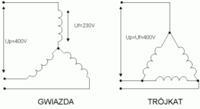Hello. Someone please enlighten me, because I`ve wondered about this several times, I`ve also tried to find the answer on the Internet, but I still don`t know.
The star-connected engine operates at 230V
The motor connected in a triangle operates at a voltage of 400V
So why on some engines the nameplate says, say, 230/400 delta/star and not star/delta. After all, a triangle is probably 400V. What this is about? Isn`t such an engine adapted to work in the Polish network?
Or an ordinary motor that I connect during practice with a time relay in the starting system has a triangle/star on the plate 400/690. Delta ok 400V but star 690V?
The star-connected engine operates at 230V
The motor connected in a triangle operates at a voltage of 400V
So why on some engines the nameplate says, say, 230/400 delta/star and not star/delta. After all, a triangle is probably 400V. What this is about? Isn`t such an engine adapted to work in the Polish network?
Or an ordinary motor that I connect during practice with a time relay in the starting system has a triangle/star on the plate 400/690. Delta ok 400V but star 690V?




